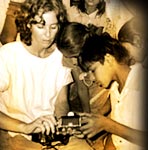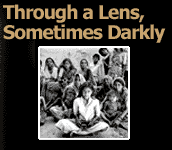The Rediff US Special/Shaheen Pasha


It was a picture perfect setting.
Wendy Ewald sat on her tiny patio in upstate New York amid a garden of blooming lilacs while her five-year-old son Michael raced through the house in search of his mother.
Dressed in comfortable gray sweat pants and a white sweater, Ewald, 49, did not look like a woman traipsing around the world, camera in hand -- and with adventure on her mind.
But pictures never lie.
Ewald, a photographer and a professor involved with a Duke University literacy programme, has spent the last 30 years on a mission to tell the untold stories of women and children across the world, including India.
She has taught hundreds of children and women to take photographs. Her latest collection, I Wanna Take Me a Picture, will be out later this year. Ewald said the book is the result of all her work and shows how others can achieve similar types of art.
While her mission may not be unique, Ewald's methods are.
By putting a camera into the hands of her subjects, she allows many poor and exploited people, including children, to overcome their inhibitions and express the world through the eyes.
She learned about the importance of visual symbols when her younger brother was hit by a car in Detroit, where they grew up. She helped him regain his speech with a game that used her own drawings. Later, she would work as a volunteer with native American children on reservations in Canada.
"Women and kids don't often think their stories are worthwhile so they don't know what to photograph," Ewald explained. "As a starting point, I usually ask them to do self-portraits, as well as their dreams and fantasies. Their inhibitions quickly go away when they start seeing what extraordinary things they can create."
Ewald's quest for the extraordinary led her to the tiny village of Vichy in Gujarat, India, in 1988 where she worked with the Self-Employed Women's Association to bring photography into the hands of children, some of whom would later take to professional photography.
"I had seen lots of photographs of India and I was amazed visually," she said. "A lot of people told me it wasn't possible to work in a village because the children wouldn't be open to technology, but I persevered and said this is what I wanted to do."
With SEWA's help, Ewald descended on the village of Vichy where a village meeting was held to decide how to proceed with the project. At least 50 children flocked to the programme, but Ewald could only accommodate 20. That was the first hurdle.
"Since I could only work with 20, I asked the children what they wanted to photograph and had them look through the camera and tell me what they saw. I wrote it down and determined how many boys and girls to let in," Ewald recalled. "But there were some kids who were really animated about learning photography and I let them come as well."
While the kids were excited, many parents were not so open.
Ewald said many parents wondered why she was not teaching the adults photography and tried to convince her that their children would not be able to learn.
"When the pictures came out, that comment wasn't heard anymore," she remarked.
But teaching the children -- many of who had no idea what photographs were -- proved to be another challenge.
Ewald began by taking by Polaroid pictures of the children so they could see how the process worked. Many of the pictures were taken in the afternoon, causing shadows to appear, making many of the children darker than they were.
"These were the first pictures in the village and they didn't have the concept that I wasn't controlling it," Ewald remembered. "The parents didn't like it and one of the girls Hansi told me that she was a Harijan and her father said I was trying to use the photos to convert her to Christianity or to take them to Delhi and America to get her married."
With this second hurdle in place, Ewald had another village meeting with the dalits to convince them she was not interested in converting their children. Eventually they agreed to let the children continue with the programme. The children learned alongside children of higher castes, such as the Patels, and eventually even Brahmin children put aside their caste biases and worked together behind the camera.
A common thread that tied together the different children was their desire to capture their Hindu gods on film. The young photographers enacted religious scenes in their photos and put together collages to create different narratives.
"I thought it was interesting that most of the kids originally told us they wanted to photograph the gods," Ewald said. "We finally realized that what they considered a photo was the laminated pictures of their gods in their houses."
As the children became more adept at the camera, disturbing and saddening stories began to emerge.
In addition to taking photographs, Ewald was interested in capturing the children's experiences on tape. She asked the children to talk about their families and the tales they would like to tell. Tape recorder in hand, the children began to tell poignant tales of the death and violence that had touched their young lives.
The tape-recorded stories, along with the photographs from India, were included in her book, I Dreamed I Had a Girl in My Pocket.
"Out of the 20 children, five had family members murdered," Ewald recalled. For many of the others, death came in the form of illnesses such as smallpox.
While death was a common theme among the children, marriage also played a large role in their young lives. Ewald remembered one 14-year-old boy named Hasmukh, in particular. "Hasmukh talked about the day he got married and it was very poignant hearing him talk about the way he dressed up when she came and how he liked having her around because he had been lonely since his two brothers died," Ewald recalled fondly.
"I remember, though, how when she didn't do something he wanted he slapped her and when he thought he would get in trouble, his father-in-law said it was okay to slap her."
Ewald stopped in the middle of reminiscing and her voice took on a sad note.
"In the last six months, one of the boys Chandrakant -- who speaks English now and keeps in touch with me -- wrote and told me that Hasmukh drank poison and died. Two of the children I taught actually died since I left."
Although Ewald left India in 1989, she hasn't forgotten the children she left behind. When the brutal earthquake hit Gujarat earlier this year, Ewald was frustrated and worried about the fate of the people she had come to know so well. While the tragedy invited photographers and journalists from all over the world, Ewald had no desire to go back to photograph the horrors.
"It seems almost exploitative," she explained. "I think it would be amazing if kids did it. I would have liked to have seen something come out so people really understood what was happening aside from the devastation."
While Ewald has travelled the globe photographing women and children in India, Saudi Arabia, Latin America and the United States, it is through her teaching that she reaches out to the most people. Ewald is a professor at the Centre of Documentary Studies at Duke University and is active in the Literacy Through Photography programme -- a partnership that she founded with public schools in Durham, North Carolina, and Duke University.
"Photographs are a universal language," Ewald said. "The way people use the pictures is culture-specific."
Back to top
Tell us what you think of this feature